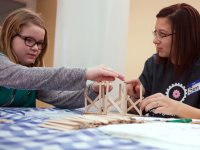How Games Can Extend Learning After the Bell
Games can provide ideal conditions for informal learning. Strong, immersive engagement means that students may not require (or desire) a classroom setting for learning.
One of the most rewarding parts of teaching is when a student returns to me with an anecdote about an informal learning community that he or she joined because of something learned in my class. For example, I use the game design website Scratch, asking students to remix an existing game to be about a topic that we're covering (e.g., turn Flappy Bird into a medieval-themed adventure). In this unit, I share links to YouTube's community of Scratch users, where more complicated projects are shared. The in-class assignment whets appetites to continue learning long after the bell rings.
There are essentially two types of education: formal and informal. Formal education takes place in classrooms, led by teachers with a prescribed curriculum. Informal learning describes education outside of school: at libraries, museums, and in online communities of practice, like the thousands of Minecraft instructional videos that students watch on YouTube. Informal education is self-directed, based on interest. Informal learning has a system of apprenticeship, in which novices learn from more experienced members.
Beyond the School Bell
This summer, I had the opportunity to meet Justin Leites, Vice President of Games for Amplify Learning, at two conferences: the Games Learning Society Conference at the University of Wisconsin-Madison, and the Serious Play Conference at Carnegie Mellon University. Leites' role at Amplify is building and curating game content to support its growing curriculum. As of summer 2015, it had about 30 games available.
The World of Lexica is a suite of interconnected English language arts games playable on iPads. This summer, the developer, Schell Games, won the 2015 Serious Play Gold Medal for creating it.
"[Lexica] takes the idea that a game is a series of meaningful choices, and then offers students meaningful choices to keep them engaged along the way," Leites explained. Lexica features a virtual library with more than 600 books, including work from contemporary authors Neil Gaiman and Lemony Snicket. With so much content, clearly it cannot be played in one 40-minute class period! Students begin reading their favorite stories and books in school and then continue from home, in informal learning settings.
In Lexica, there are quests in which students can interact with book characters. "One of my favorite things is, if you read a book, the characters will initiate interesting conversations about things you read," Leites continued. "It's an interesting engagement tool."
A good learning game has the potential to engage high-order cognitive thinking for long periods of time. After all, children play games like Minecraft and Little Big Planet for hours because they're mentally engaging and satisfying. "Extending learning beyond the classroom is something middle school teachers asked us for," recalled Leites. "That was a major design goal."
Learning from Fun Failure
Twelve a Dozen is a math game co-developed by Amplify with Bossa Studios. It can be played as a standalone application, available for most mobile devices. Twelve a Dozen teaches the order of operations -- a precursor for middle school algebra. The game was created with the design philosophy of always making failure fun.
Games like Twelve a Dozen encourage persistence through trial and error. In fact, there are no negative consequences for trying and not succeeding with different strategies. Twelve a Dozen borrows the “rewind” mechanic from The Prince of Persia games: do something wrong and rewind the action so that you can try again! After all, failure is part of the learning process.
Games like this are an example of what psychologist Carol Dweck calls the growth mindset, a state in which "people believe that their most basic abilities can be developed through dedication and hard work -- brains and talent are just the starting point."
A Community of Informal Learning
Informal learning works best when there is a community of practice supporting it. Often, it may be a digital community. In a K-12 setting, administrators and teachers may have trepidations about the online social interactions that support informal learning. One solution is when learning communities exist within the "walled garden" of a classroom, grade level, or school. MinecraftEdu is a good model of how learning can take place using a closed server, managed by the teacher and accessible only to the students.
Game-based learning is an approach that can inspire student-directed informal learning. Try having students play a game in pairs in the classroom and then ask them to try it single player from home to see how the decision-making process changes. "Games throughout human history are played together. And it is especially true for this generation!" Leites explained. "We discovered that, even when we gave a kid a game like solitaire, they'd ask, 'How do I play this with my friends?' That's the challenge right now."
